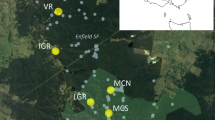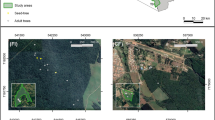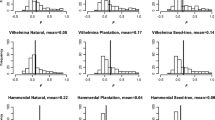Abstract
Whitebark pine (Pinus albicaulisEngelm.) is threatened across its native rangeby an exotic fungal pathogen introduced withinthe last century. Mortality has beenextensive, and projected potential range shiftsbased on impending climate change have revealedfurther pressures to survival and adaptationfor this long-lived, high-elevation conifer. Quantifying genetic variation and the matingsystem of whitebark pine in its northern rangeprovides a basis for effective conservationmeasures. Isozyme analysis of vegetative budtissue revealed high expected heterozygosity(0.262), moderate population differentiation(FST = 0.061) and highly significantcorrelations between observed heterozygosityand geographic variables (R2 = 0.36,latitude; R2 = 0.30 longitude), supportingthe hypothesis that this species recolonizedits current northern range following glacialretreat from several refugia in the Washingtonand Oregon Cascades and in the northernRockies. Mating system analysis based onsimultaneous isozyme analyses of embryo andhaploid megagametophyte tissues foundrelatively high levels of consanguineous matingand selfing for a conifer (t m =0.73) within populations. Avian seeddistribution by the Clark's nutcracker (Nucifragia columbiana Wilson) appears to bethe overriding factor influencing geneticpatterns: being a mutualistic seed disperser,caches comprised of related seeds develop intoclumped stands with strong family substructure. While it is a critical wildlife habitatcomponent, lack of commercial utilization hasmade in situ adaptation the primaryconservation focus. Encouraging regenerationsuccess and nutcracker caching by maintainingnatural fire regimes will provide anecosystem-based conservation solution; however,in the Rocky Mountains between 52° N and47° N, disease-resistant individualsshould be located and propagated in order toensure long-term survival of the species inhigh pathogen hazard areas.
Similar content being viewed by others
References
Arno SF, Hoff RJ (1990) Pinus albicaulis Engelm. In: Silvics of North America, Vol. 1. Conifers (tech. co-ords. Burns RM, Honkala BH), pp. 268–279. Agriculture Handbook 654, USDA For. Serv., Washington D.C.
Baker BH, Amman GD, Trostle GC (1971) Does the mountain pine beetle change hosts in mixed lodgepole and whitebark pine stands? USDA For. Serv. Res. Note, INT-151. Ogden, UT.
Berg EE, Hamrick JL (1997) Quantification of genetic diversity at allozyme loci. Can. J. For. Res., 27, 415–424.
Bruederle LP, Tomback DF, Kelly KK, Hardwick RC (1998) Population genetic structure in a bird-dispersed pine, Pinus albicaulis (Pinaceae). Can. J. Bot., 76, 83–90.
Burdon JJ, Thrall PH, Brown AHD (1999) Resistance and virulence structure in two Linum marginale-Melampsora lini host-pathogen populations with different mating systems. Evol., 53, 704–716.
Bush RM, Smouse PE (1992) Evidence for the adaptive significance of allozymes in forest trees. New For., 6, 179–196.
Callaway RM (1998) Competition and facilitation on elevation gradients in subalpine forests of the northern Rocky Mountains, USA. Oikos, 82, 561–573.
Campbell EM, Antos JA (2000) Distribution and severity of white pine blister rust and mountain pine beetle on whitebark pine in British Columbia. Can. J. For. Res., 30, 1051–1059.
Cavalli-Sforza JL, Edwards DW (1967) Phylogenetic analysis: Models and estimation procedures. Evol., 21, 550–570.
Clayton JB, Tretiak EM (1972) Differences in allozyme variation in Atlantic herring. J. Fish Res. Board Can., 35, 1167–1170.
Comps B, Gömöry D, Letouzey J, Thiébaut B, Petit RJ (2001) Diverging trends between heterozygosity and allelic richness during postglacial colonization in the European beech. Genetics, 157, 389–397.
Conkle MT (1971) Isozyme specificity during germination and early growth of knobcone pine. For. Sci., 17, 494–498.
Critchfield WB (1986) Hybridization and classification of the white pines (Pinus section Strobus). Taxon, 35, 647–656.
Cuguen J, M erzeau D, Thiébaut B (1988) Genetic structure of the European beech stands (Fagus sylvatica L.): F-statistics and importance of mating system characteristics in their evolution. Hered., 60, 91–100.
Delcourt PA, Delcourt HR (1998) Paleoecological insights on conservation of biodiversity: A focus on species, ecosystems and landscapes. Ecol. Appl., 8, 921–934.
El-Kassaby YA (1984) Variation in the outcrossing rate among crown strata of Sitka spruce. Silvae Gen., 32, 232–237.
El-Kassaby YA, Meagher MD, Parkinson J, Portlock FT (1987) Allozyme inheritance, heterozygosity and outcrossing rate among Pinus monticola near Ladysmith, British Columbia. Hered., 58, 173–181.
El-Kassaby YA, Meagher MD, Davidson R (1993) Temporal variation in the outcrossing rate in a natural stand of western white pine. Silvae Gen., 42, 131–135.
Furnier GR, Adams WT (1986) Mating system in natural populations of Jeffrey pine. Am. J. Bot., 73, 1002–1008.
Hamrick JL, Godt M-JW, Sherman-Broyles SL (1992) Factors influencing levels of genetic diversity in woody plant species. New For., 6, 95–124.
Hoff RJ, Hagle SK, Krebill RG (1994) Genetic consequences and research challenges of blister rust in whitebark pine forests. In: Proceedings of an International Workshop on Subalpine Stone Pines and Their Environment: The Status of Our Knowledge, pp. 118–126, 21. USDA For. Serv. Tech. Rep. INT-184. Ogden, UT.
Hoff RJ, Ferguson DE, McDonald GI, Keane RE (2001) Strategies for managing whitebark pine blister rust. In: Whitebark Pine Communities: Ecology and Restoration (eds. Tomback DF, Arno SF, Keane RE), pp. 346–366. Island Press, Washington D.C.
Huntley B (1991) How plants respond to climate change: Migration rates, individualism and the consequences for plant communities. Ann. Bot., 67(Supp. 1), 15–22.
Intergovernmental Panel on Climate Change (2001) Climate Change 2001: Impacts, Adaptation, and Vulnerability.
Jorgensen SM, Hamrick JL (1997) Biogeography and population genetics of whitebark pine, Pinus albicaulis. Can. J. For. Res., 27, 1574–1585.
Keane RE, Arno SF (1993) Rapid decline of whitebark pine in western Montana: Evidence from 20-year remeasurements. W. J. Appl. For., 8, 44–47.
Kendall KC, Arno SF (1992) Whitebark pine-an important but endangered wildlife resource. In: Proceedings of a Symposium on Whitebark Pine Ecosystems: Ecology and Management of a High-Mountain Resource, pp. 264–273. USDA For. Serv. Tech. Rep. INT-176, Bozeman, MT.
Kormuták A, Lindgren D (1996) Mating system and empty seeds in silver fir (Abies alba Mill.). For. Genet., 3, 231–235.
Krutovskii KV, Politov DV, Alkhutov YP (1995) Isozyme study of population genetic structure, mating system and phylogenetic relationships of the five stone pine species (subsection Cembrae, section Strobi, subgenus Strobus). In: Population Genetics and Conservation of Forest Trees (eds. Baradat P, Adams WT, Müller-Starck G), pp. 270–304. SPB Acad. Pub., the Netherlands.
Lanner RM (1982) Adaptations of whitebark pine for seed dispersal by Clark's nutcracker. Can. J. For. Res., 12, 391–402.
Leadam CL (1986) Seed dormancy in three Pinus species of the inland mountain west. In: Proceedings: Conifer Tree Seed in the Inland Mountain West Symposium, pp. 117–124. USDA For. Serv. Res. Rep. 230, Missoula, MT.
Ledig FT (1988) The conservation of diversity in forest trees: Why and how should genes be conserved? BioScience, 38, 471–479.
Ledig FT, Conkle MT, Bermejo-Velásquez B, Eguiluz-Piedra T, Hodgskiss PD, Johnson DR, Dvorak WS (1999) Evidence for an extreme bottleneck in a rare Mexican pinyon: Genetic diversity, disequilibrium, and the mating system in Pinus maximartinezii. Evol., 53, 1–99.
Liedloff RT (1999) Mantel Nonparametric Test Calculator V.2.00© http://www.mantel.com
Mattson DJ, Reinhart DP (1997) Excavation of red squirrel middens by grizzly bears in the whitebark pine zone. J. Appl. Ecol., 34, 926–940.
McCaughey WW, Schmidt WC (2001) Taxonomy, distribution and history. In: Whitebark Pine Communities: Ecology and Restoration (eds. Tomback DF, Arno SF, Keane RE), pp. 29–40. Island Press, Washington D.C.
McKay JK, Latta RG (2002) Adaptive population divergence: Markers, QTL and traits. Trends Ecol. Evol., 17, 285–291.
Mitton JB, Linhart YH, Sturgeon SW, Farrar JP (1977) Protein polymorphisms detected in mature needle tissue of ponderosa pine. Am. J. Bot., 42, 1154–1157.
Mitton JB, Linhart YB, Davis ML, Sturgeon KB (1981) Estimation of outcrossing in ponderosa pine, Pinus ponderosa Laws., from patterns of segregation of protein polymorphisms and from frequencies of albino seedlings. Silvae Gen., 30, 117–121.
Mitton JK, Kreiser BR, Latta RG (2000) Glacial refugia of limber pine (Pinus flexilis James) inferred from the population structure of mitochondrial DNA. Mol. Ecol., 9, 91–97.
Nei M (1972) Genetic distance between populations. Am. Nat., 106, 283–291.
Ohta T (1982) Linkage disequilibrium with the island model. Genetics, 101, 139–155.
Perkins DL, Swetnam TW (1996) A dendroecological assessment of whitebark pine in the Sawtooth–Salmon River region, Idaho. Can. J. For. Res., 26, 2123–2133.
Perry DJ, Dancik BP (1985) Mating system dynamics of lodgepole pine in Alberta, Canada. Silvae Gen., 35, 190–195.
Petit RJ, Bahrman N, Baradat PH (1995) Comparison of genetic differentiation in maritime pine (Pinus pinaster Ait.) estimated using isozyme, total protein and terpenic loci. Hered., 75, 382–389.
Pitel JA, Wang BSP (1992) Physical and chemical treatments to improve germination of whitebark pine seed. In: Proceedings of a Symposium on Whitebark pine Ecosystems: Ecology and Management of a High-Mountain Resource, pp. 130–133. USDA For. Serv. Bozeman, MT.
Price RA, Liston A, Strauss SH (1998) Phylogeny and systematics of Pinus. In: Ecology and Biogeography of Pinus (ed. Richardson DM), pp. 49-68. Cambridge Univ. Press, Cambridge, MA.
Richardson BA, Brunsfeld SJ, Klopfenstein NB (2002) DNA from bird-dispersed seed and wind-disseminated pollen provides insights into postglacial colonization and population genetic structure of whitebark pine (Pinus albicaulis). Mol. Ecol., 11, 215–227.
Ridgeway FT, Conway SC, Maples M (1970) Polymorphic protein detected in brook trout. J. Fish., 42, 166–171.
Ritland K (1990) A series of FORTRAN computer programs for estimating plant mating systems. J. Hered., 81, 235–237.
Rogers DL, Millar CI, Westfall RD (1999) Fine-scale genetic structure of whitebark pine (Pinus albicaulis): Associations with watershed and growth form. Evolution, 53, 74–90.
Shafer SL, Bartlein PJ, Thompson RS (2001) Potential changes in the distributions of western North America tree and shrub taxa under future climate scenarios. Ecosystems, 4, 200–215.
Stuart-Smith GJ (1998) Conservation of Whitebark Pine in the Canadian Rockies: Blister Rust and Population Genetics. MSc Thesis, University of Alberta, Edmonton, AB.
Swofford DL, Selander RB, Black IV WC (1997) BIOSYS-2: A computer program for the analysis of allelic variation in genetics.
Tomback DF (1982) Dispersal of whitebark pine seeds by Clark's nutcracker: A mutualism hypothesis. J. Animal Ecol., 51, 451–467.
Tomback DF, Arno SF, Keane RE (2001) The compelling case for management intervention. In: Whitebark Pine Communities: Ecology and Restoration (eds. Tomback DF, Arno SF Keane RE), pp. 3–25. Island Press, Washington D.C.
Vander Wall SB, Balda RP (1977) Coadaptations of the Clark's nutcracker and the piñon pine for efficient seed harvest and dispersal. Ecol. Monogr., 4, 89–111.
Wheeler NC, Guries RP (1982) Population structure, genic diversity, and morphological variation in Pinus contorta Dougl. Can. J. For. Res., 12, 595–606.
Widmer A, Lexer C (2001) Glacial refugia: sanctuaries for allelic richness, but not for gene diversity. Trends Ecol. Evol., 16, 267–269.
Wilson B, Stuart-Smith J (2002) Whitebark Pine Conservation for the Canadian Rocky Mountain National Parks. Cordilleran Ecological Research, Winlaw, B.C.
Wright S (1931) Evolution in Mendelian populations. Genetics, 16, 97–159.
Wright S (1965) The interpretation of population structure by Fstatistics with special regard to systems of mating. Evol., 19, 395–420.
Yanchuk AD (2001) A quantitative framework for breeding and conservation of forest tree genetic resources in British Columbia. Can. J. For. Res., 71, 566–576.
Yandell UG (1992) An Allozyme Analysis of Whitebark Pine (Pinus albicaulis Engl.). MSc Thesis, University of Nevada, Reno, NV.
Yeh FC, Yang R-C, Boyle T (1999) Popgene Version 3.2: Microsoft Window-Based Freeware for Population Genetic Analysis.
Zeglen S (2002) Whitebark pine and white pine blister rust in British Columbia, Canada. Can. J. For. Res., 32, 1265–1274.
Author information
Authors and Affiliations
Corresponding author
Rights and permissions
About this article
Cite this article
Krakowski, J., Aitken, S. & El-Kassaby, Y. Inbreeding and conservation genetics in whitebark pine. Conservation Genetics 4, 581–593 (2003). https://doi.org/10.1023/A:1025667700479
Issue Date:
DOI: https://doi.org/10.1023/A:1025667700479




